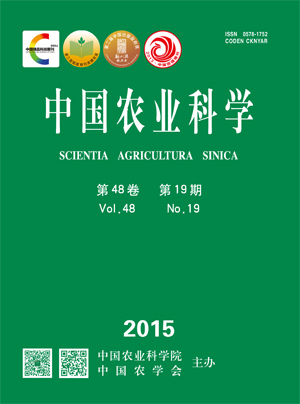-
Molecular Detection for Quality Traits-Related Genes in Yangmai Series Wheat Cultivars
- ZHANG Xiao, ZHANG Bo-qiao, JIANG Wei, Lü Guo-feng, ZHANG Xiao-xiang, LI Man, GAO De-rong
-
Scientia Agricultura Sinica. 2015, 48(19):
3779-3793.
doi:10.3864/j.issn.0578-1752.2015.19.001
-
 Abstract
(
677 )
Abstract
(
677 )
 HTML
(
11 )
HTML
(
11 )
 PDF (1099KB)
(
554
)
PDF (1099KB)
(
554
)
 Save
Save
-
References |
Related Articles |
Metrics
【Objective】The purpose of this study is to clarify the distribution of quality-related genes in Yangmai series wheat varieties and provide guidance for wheat genetic breeding and production. 【Method】Single pedigree of twenty-one Yangmai wheat varieties were selected. Grain hardness was measured by single grain analyzer SKCS-4100. Hardness gene, low molecular weight glutenin subunit gene (LMW-GS), Wx gene coding key enzyme for amylose synthesis, polyphenol oxidase (PPO) gene, yellow pigment content (PSY) gene and pre-harvest sprouting tolerance (Vp1) gene were detected in twenty-one Yangmai wheat varieties by their corresponding functional markers through polyacrylamide gel electrophoresis technology, while high molecular weight glutenin subunits(HMW-GS)and Wx protein subunits composition were detected by SDS-PAGE. 【Result】There are sixteen soft wheat through grain hardness analyzer, which accounted for 76.19%, however, the hard and mixed wheat only accounted for 19.05% and 4.76%, respectively. In hardness and mixed wheat, there are four varieties with pinb-D1b mutation, but in sixteen soft wheat, no mutation of Pinb-D1b was found. When detecting the composition of HMW-GS, allele 1 and Null accounted for 38.10% and 61.90%, respectively, at the Glu-A1 locus, and allele 7+8 and 7+9 at Glu-B1 took up 57.14% and 42.86%, respectively, whereas at the Glu-D1 locus, allele 2+12 was 85.71%, 5+10 was 14.29%, respectively. Meanwhile, for LMW-GS compositions, “Glu-A3c, Glu-B3g” was the main genotype. Genotype frequencies of Glu-A3c and Glu-A3d were 90.48% and 9.52%, respectively. Glu-B3g and Glu-B3i frequencies were 95.24% and 4.76%, respectively. Molecular detection indicated that the allele variation Wx-B1b which resulted inthe subunit Wx-B1 deletion was only found in Yangmai13. However, SDS-PAGE method turned out that Yangmai13 and Yangmai5 both lacked Wx-B1 subunit. Results also showed that, in all twenty-one Yangmai varieties, at 2AL locus for PPO activity, the frequency of Ppo-A1a for high PPO activity was 52.38%, and Ppo-A1b related low PPO activity was 42.86%. Apart from Ppo-A1b, another low PPO related gene Ppo-D1 located on 2DL, whose frequency was 90.48%. It was also found that phytoene synthase genes Psy-A1a and Psy-A1b accounted for 19.05% and 80.95%, respectively. When detecting pre-harvest sprouting tolerance gene with marker Vp1B3, tolerant genotype Vp1Bc and susceptible genotype Vp1Bawere amplified in this report, accounting for 90.48% and 9.52%, respectively.【Conclusion】Most Yangmai varieties were soft wheat, which was due to the pinb-D1a genotype at pinb-D1 locus, Null and 2 + 12 at Glu-A1 and Glu-D1 loci and Glu-A3c at Glu-A3 locus. These varieties can be applied as donor parents in weak gluten wheat breeding. Quality of middle-gluten wheat Yangmai15 and Yangmai16 were superior mostly because of the Pinb-D1 locus mutation, so the selection of Pinb-D1 mutation should be enhanced in quality improvement breeding for middle-gluten wheat. Yangmai1, Yangmai4, Yangmai5, Yangmai9, Yangmai18, Yangmai19 and Yangmai22 with low polyphenol oxidase activities and low yellow pigment content could be used as donors for selecting materials with high flour whiteness and good color. Yangmai158, Yangmai10, Yangmai16 and Yangmai17 varieties with Pinb-D1b allele, Yangmai2, Yangmai4 and Yangmai5 with subunit pair of “5+10” at Glu-D1 locus, Yangmai13 and Yangmai5 with Wx-B1 deletion, could be applied to the protein and starch quality improvement of middle-gluten wheat for their high quality traits.









